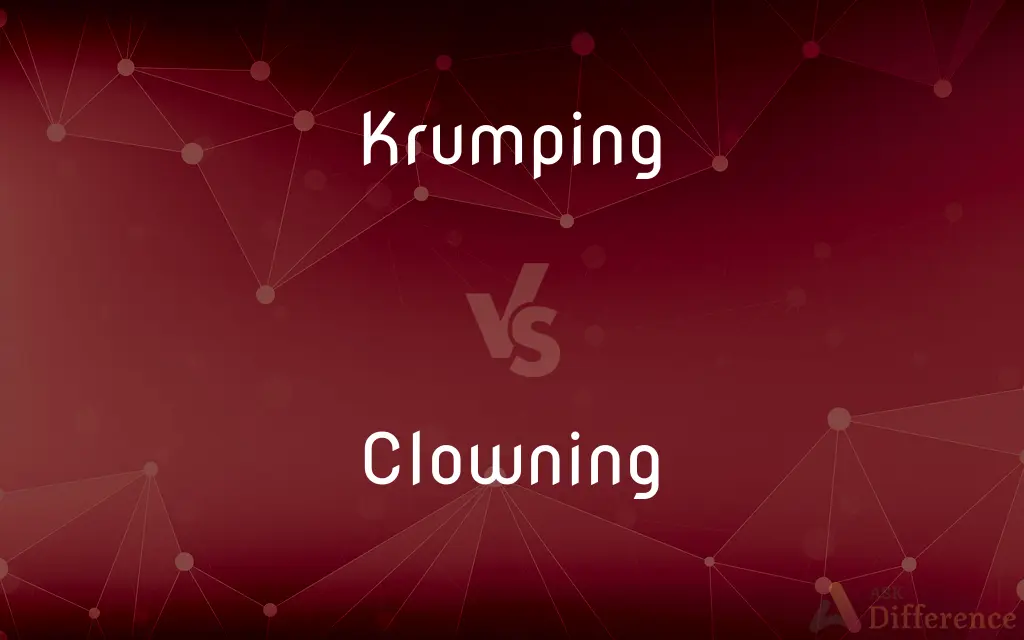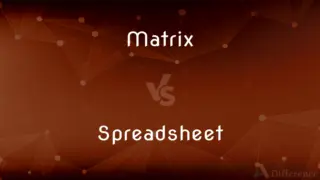Krumping vs. Clowning — What's the Difference?
Edited by Tayyaba Rehman — By Fiza Rafique — Updated on April 18, 2024
Krumping is an energetic, expressive street dance characterized by free, exaggerated movements, while clowning involves theatrical gestures and humor to entertain and interact with audiences.

Difference Between Krumping and Clowning
Table of Contents
ADVERTISEMENT
Key Differences
Krumping is a high-energy dance style that originated in the early 2000s in Los Angeles as a form of releasing anger and emotions through movement. Whereas, clowning, which has been around for centuries, focuses more on performance art that includes comedy, drama, and mime to engage and amuse an audience.
The movements in krumping are aggressive and intense, involving stomps, arm swings, and chest pops. On the other hand, clowning movements are generally exaggerated but more controlled, aiming to tell a story or joke through physical humor.
Krumping dancers, known as krumpers, often battle in competitions to showcase their skills. Meanwhile, clowns perform at various events like circuses and parties, where interaction with the audience is key to their act.
The attire for krumping is usually urban streetwear, reflecting its roots in street culture. Conversely, clowning attire is very distinctive, featuring colorful wigs, makeup, and costumes that are integral to creating the clown's persona.
Music plays a crucial role in krumping, with dancers moving to the beats of hip-hop or intense electronic sounds. In contrast, clowning may involve a variety of musical styles and often incorporates props and instruments for comedic effect.
ADVERTISEMENT
Comparison Chart
Origin
Early 2000s, Los Angeles
Ancient theatrical traditions
Key Elements
Aggressive movements, battles
Comedy, interaction, mime
Attire
Urban streetwear
Colorful costumes, makeup, wigs
Performance
Dance competitions
Circuses, parties, entertainment
Music
Hip-hop, electronic
Various, often includes props
Compare with Definitions
Krumping
Characterized by freestyle dance battles and intense physical activity.
Krumping competitions often attract dancers who express themselves through powerful moves.
Clowning
A performance art that uses humor, mime, and interaction to entertain audiences.
She studied clowning to enhance her skills in theatrical comedy.
Krumping
A street dance form known for its expressive, energetic movements.
He excels in krumping, using the dance as an emotional outlet.
Clowning
Often involves creating a persona to perform various comedic routines.
His clowning routine at the circus was a hit among children.
Krumping
Usually performed to high-tempo and aggressive music that enhances the dance's intensity.
The krumping session energized everyone at the dance studio.
Clowning
Uses a variety of props, such as balloons, magic tricks, and slapstick, to engage the audience.
The clowning act included juggling and balloon animals, which delighted the audience.
Krumping
Krumping is a style of street dance popularized in the United States, described as Afro-diasporic dance, characterized by free, expressive, exaggerated, and highly energetic movement.
Clowning
See krumping.
Krumping
A style of dance combining convulsive arm movements with energetic movements adapted from various urban dance forms. Also called clowning.
Clowning
Present participle of clown
Krumping
A free, expressive and energetic style of hip-hop dancing.
Clowning
Clownish behaviour.
Clowning
Acting like a clown or buffoon.
Clowning
A comic incident or series of incidents.
Clowning
Acting like a clown or buffoon
Clowning
A comic incident or series of incidents
Common Curiosities
How did krumping originate
Krumping originated in the early 2000s in Los Angeles as a form of street dance.
What are the typical venues for clowning performances
Clowning performances are common at circuses, festivals, and children’s parties.
What type of music is associated with krumping
Krumping is typically performed to aggressive hip-hop or electronic music.
Is krumping used for storytelling
Unlike clowning, krumping primarily focuses on expression and competition rather than storytelling.
Can clowning be considered a form of dance
While clowning includes physical movements, it is more broadly a form of theatrical performance rather than just dance.
What is krumping
Krumping is an energetic dance style that emphasizes free, exaggerated, and expressive movements.
Do krumpers wear special costumes
Krumpers usually wear urban streetwear, which reflects the dance's street culture origins.
What is clowning
Clowning is a performance art that combines humor, mime, and character interaction to entertain audiences.
Are there competitions for krumping
Yes, krumping often involves dance battles and competitions to showcase dancers' skills.
How do clowns interact with their audience
Clowns interact with their audience through jokes, mimicry, and direct engagement during performances.
What skills are important for a clown
A clown must be skilled in mime, humor, and audience interaction.
What emotional tone is associated with krumping
Krumping often expresses intense emotions like anger and joy through vigorous movements.
Share Your Discovery

Previous Comparison
Matrix vs. Spreadsheet
Next Comparison
Mountain vs. ValleyAuthor Spotlight
Written by
Fiza RafiqueFiza Rafique is a skilled content writer at AskDifference.com, where she meticulously refines and enhances written pieces. Drawing from her vast editorial expertise, Fiza ensures clarity, accuracy, and precision in every article. Passionate about language, she continually seeks to elevate the quality of content for readers worldwide.
Edited by
Tayyaba RehmanTayyaba Rehman is a distinguished writer, currently serving as a primary contributor to askdifference.com. As a researcher in semantics and etymology, Tayyaba's passion for the complexity of languages and their distinctions has found a perfect home on the platform. Tayyaba delves into the intricacies of language, distinguishing between commonly confused words and phrases, thereby providing clarity for readers worldwide.













































